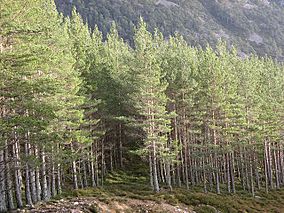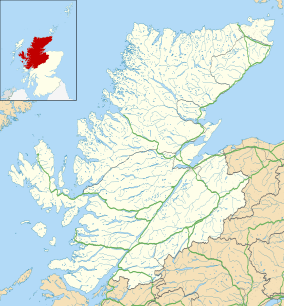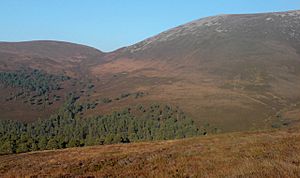Invereshie and Inshriach National Nature Reserve facts for kids
Quick facts for kids Invereshie and Inshriach National Nature Reserve |
|
|---|---|
|
IUCN Category IV (Habitat/Species Management Area)
|
|

Scots pines below the crags of Creag Mhigeachaidh
|
|
| Location | Highland, Scotland |
| Area | 37.3 km2 (14.4 sq mi) |
| Designation | NatureScot |
| Established | 2007 |
| Owner | NatureScot & Forestry and Land Scotland |
| Invereshie and Inshriach National Nature Reserve | |
Invereshie and Inshriach (which is Inbhir Fheisidh agus Na h-Innse Riabhaich in Scottish Gaelic) is a special place in Scotland. It is a national nature reserve. This means it is protected to keep its amazing nature safe.
The reserve is on the western side of the Cairngorms mountains. It has many different types of land. You can find Caledonian Forest by the River Feshie. There are also bogs and open moorland. Higher up, it becomes an arctic-alpine area, like the Arctic. The tall mountain Sgòr Gaoith is on its eastern edge.
The forests here are part of a huge area of Caledonian pinewood. This forest stretches from Glen Feshie to Abernethy. It is the biggest area of this type of forest left in Scotland. NatureScot and Forestry and Land Scotland (FLS) work together to look after the reserve. NatureScot owns the Invereshie part, and FLS owns the Inshriach part.
There are no marked paths in the reserve. But some trails do go through it. These start from Coire Ruadh or Achlean in Glen Feshie. Many people use these paths to walk up to the top of Sgòr Gaoith mountain.
Contents
Amazing Plants and Animals
The most important part of this reserve is the Caledonian Forest. This forest grows between 250 and 630 meters above sea level. Invereshie is thought to have one of the best examples of this forest. Its natural tree line at Creag Fhiaclach is very special.
Forest Life
The forest is mostly made of Scots pine trees. You can also find rowan, birch, aspen, alder, juniper, and holly trees. Some parts of Inshriach used to have non-native trees. These were planted for wood. But most of them have been removed. Now, these areas are growing back into natural pine forests.
The forest floor is full of plants. These include heather, blaeberry, and cowberry. Many kinds of mosses, lichens, and fungi also grow here. There are also wet areas called bog woodlands. Here, plants like cross-leaved heath, cotton grass, and different sphagnum mosses grow well.
Mountain Plants
At the higher edges of Invereshie, the weather is harsh. Pines and juniper trees grow twisted and small here. This is called krummholz. Above the krummholz, the land is open. It has wet and dry heaths and blanket bog. These mountain areas have plants that can live in tough conditions. Some examples are twinflower, cloudberry, bladderwort, yellow saxifrage, alpine lady’s mantle, trailing azalea, and purple saxifrage.
Insects and Bugs
Wood ants are very important in the Caledonian Forest. Many other small creatures live here too. Some are rare in Britain. The green hairstreak butterfly is one example. You might also see the large heath, dingy skipper, and pearl-bordered fritillary butterflies. Rare hoverflies and horseflies also live here.
The bog woodlands are home to dragonflies and damselflies. These include the northern damselfly, which is Scotland’s rarest. You can also find the northern emerald and the white-faced darter. On the high mountain plateau, the black mountain moth has been seen.
Birds of the Reserve
Many rare birds live in the woodland. These include the Scottish crossbill, which is found only in Scotland. You can also spot the crested tit, capercaillie, and black grouse. Invereshie and Inshriach has the most successful breeding group of capercaillie in Scotland.
Higher up in the mountains, you can find ptarmigan and snow bunting. In summer, birds like the dotterel come to breed. Large birds of prey also fly overhead. These include the golden eagle, merlin, and osprey.
Mammals and Other Animals
The streams and lochs in the forest are perfect for otters. Red squirrels and pine martens are common in the pine forest. You might also see pipistrelle and brown long-eared bats. In the mountain areas, there are many mountain hare.
History of the Reserve
The Caledonian Forest first grew in Invereshie and Inshriach after the last ice age. People have lived in this area since the Bronze Age. But the forest stayed mostly untouched until the mid-1700s. People only cut a few trees for their homes. They also let animals graze a little.
Forest Changes Over Time
In the late 1700s, more people moved to Scotland. They came to the glens of the Cairngorms, like Glen Feshie. Land was cleared for farming. This happened even faster during the Napoleonic Wars. More wood was needed then. Sawmills were built along the River Feshie.
The need for wood continued in the 1800s. This was especially true with the coming of the railways. Wood was needed for railway sleepers, bridges, and buildings. In 1850, Invereshie became a "deer forest." This meant it was used for deer stalking and grouse shooting. These activities were popular with rich people. More deer meant less new trees could grow naturally. Also, people burned patches of heather to help grouse. This also stopped new trees from growing.
Protecting the Forest
The demand for wood grew again during the First and Second World Wars. By the end of the Second World War, only forests in very remote parts of Scotland were still healthy. After the wars, people became more interested in saving the remaining woodlands.
In 1954, the Nature Conservancy (NC) bought Invereshie. It became part of the Cairngorms National Nature Reserve. The NC and later groups worked to help the forest grow back. They reduced the number of deer. They also put up fences to keep deer out. And they planted native trees.
The Inshriach Estate was owned by the Forestry Commission. In the 1960s and 70s, Inshriach was used for growing trees to sell. Non-native trees like sitka spruce and lodgepole pine were planted. But since the 1990s, things have changed. The Commission started working to bring back the native forest.
Creating the Reserve
In 2006, the Cairngorms NNR was reviewed. It was decided to split it into smaller reserves. These new reserves would match how the land was already managed. The new Invereshie and Inshriach NNR was created in September 2007. It joined the Invereshie land (owned by SNH) with part of Inshriach Forest. This part of Inshriach had not been in the Cairngorms NNR before.
Special Protection for Nature
Invereshie and Inshriach is a national nature reserve (NNR). But it also has other special protections in Scotland. It is part of the Cairngorms Site of Special Scientific Interest (SSSI). It is also part of the Cairngorms Special Protection Area (SPA). And it is a Cairngorms Special Area of Conservation (SAC). The reserve is also inside the Cairngorms National Park. The International Union for the Conservation of Nature (IUCN) calls Invereshie and Inshriach a Category IV protected area. This means it is managed mainly for protecting habitats and species.



